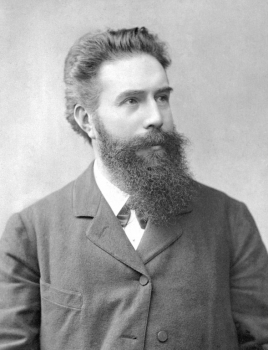
noun
- Wil·helm Kon·rad [wil-helm kon-rad; German vil-helm kawn–raht] /ˈwɪl hɛlm ˈkɒn ræd; German ˈvɪl hɛlm ˈkɔn rɑt/, 1845–1923, German physicist: discoverer of x-rays 1895; Nobel prize 1901.
- (lowercase) Physics. a unit of exposure dose that measures x-rays or gamma rays in terms of the ions or electrons produced in dry air at 0° C and one atmosphere, equal to the amount of radiation producing one electrostatic unit of positive or negative charge per cubic centimeter of air. Abbreviation: r, R
adjective
- (sometimes lowercase) of or relating to Wilhelm Roentgen, the Roentgen unit, or especially to x-rays.
noun
- a unit of dose of electromagnetic radiation equal to the dose that will produce in air a charge of 0.258 × 10 –3 coulomb on all ions of one sign, when all the electrons of both signs liberated in a volume of air of mass one kilogram are stopped completelySymbol: R, r
noun
- Wilhelm Konrad (ˈvɪlhɛlm ˈkɔnraːt). 1845–1923, German physicist, who in 1895 discovered X-rays: Nobel prize for physics 1901
1896, in Roentgen rays “X-rays,” in recognition of German physicist Wilhem Conrad Röntgen (1845-1923), who discovered X-rays in 1895. As a unit of exposure to radiation, it is attested from 1922, proposed in French in 1921.
n.
- A unit of radiation exposure that is equal to the quantity of ionizing radiation that will produce one electrostatic unit of electricity in one cubic centimeter of dry air at 0°C and standard atmospheric pressure.
- German physicist who discovered x-rays and developed x-ray photography, revolutionizing medical diagnosis. He won a 1901 Nobel Prize.
- German physicist who discovered x-rays in 1895 and went on to develop x-ray photography, which revolutionized medical diagnosis. In 1901 he was awarded the Nobel Prize for physics.
 Liberal Dictionary English Dictionary
Liberal Dictionary English Dictionary